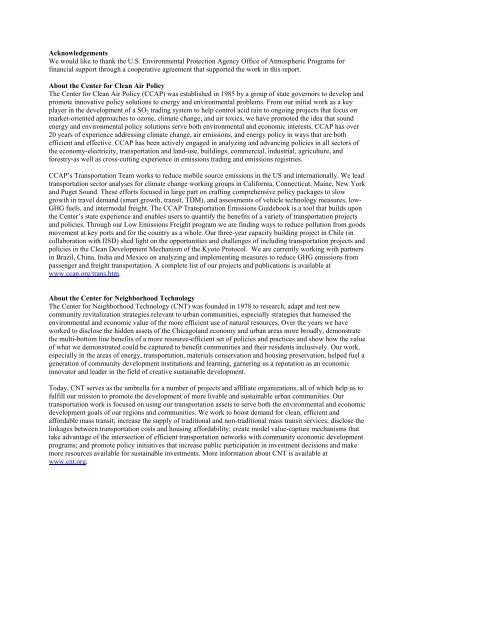High Speed Rail - Center for Neighborhood Technology
High Speed Rail - Center for Neighborhood Technology
High Speed Rail - Center for Neighborhood Technology
Create successful ePaper yourself
Turn your PDF publications into a flip-book with our unique Google optimized e-Paper software.
Acknowledgements<br />
We would like to thank the U.S. Environmental Protection Agency Office of Atmospheric Programs <strong>for</strong><br />
financial support through a cooperative agreement that supported the work in this report.<br />
About the <strong>Center</strong> <strong>for</strong> Clean Air Policy<br />
The <strong>Center</strong> <strong>for</strong> Clean Air Policy (CCAP) was established in 1985 by a group of state governors to develop and<br />
promote innovative policy solutions to energy and environmental problems. From our initial work as a key<br />
player in the development of a SO2 trading system to help control acid rain to ongoing projects that focus on<br />
market-oriented approaches to ozone, climate change, and air toxics, we have promoted the idea that sound<br />
energy and environmental policy solutions serve both environmental and economic interests. CCAP has over<br />
20 years of experience addressing climate change, air emissions, and energy policy in ways that are both<br />
efficient and effective. CCAP has been actively engaged in analyzing and advancing policies in all sectors of<br />
the economy-electricity, transportation and land-use, buildings, commercial, industrial, agriculture, and<br />
<strong>for</strong>estry-as well as cross-cutting experience in emissions trading and emissions registries.<br />
CCAP’s Transportation Team works to reduce mobile source emissions in the US and internationally. We lead<br />
transportation sector analyses <strong>for</strong> climate change working groups in Cali<strong>for</strong>nia, Connecticut, Maine, New York<br />
and Puget Sound. These ef<strong>for</strong>ts focused in large part on crafting comprehensive policy packages to slow<br />
growth in travel demand (smart growth, transit, TDM), and assessments of vehicle technology measures, low-<br />
GHG fuels, and intermodal freight. The CCAP Transportation Emissions Guidebook is a tool that builds upon<br />
the <strong>Center</strong>’s state experience and enables users to quantify the benefits of a variety of transportation projects<br />
and policies. Through our Low Emissions Freight program we are finding ways to reduce pollution from goods<br />
movement at key ports and <strong>for</strong> the country as a whole. Our three-year capacity building project in Chile (in<br />
collaboration with IISD) shed light on the opportunities and challenges of including transportation projects and<br />
policies in the Clean Development Mechanism of the Kyoto Protocol. We are currently working with partners<br />
in Brazil, China, India and Mexico on analyzing and implementing measures to reduce GHG emissions from<br />
passenger and freight transportation. A complete list of our projects and publications is available at<br />
www.ccap.org/trans.htm.<br />
About the <strong>Center</strong> <strong>for</strong> <strong>Neighborhood</strong> <strong>Technology</strong><br />
The <strong>Center</strong> <strong>for</strong> <strong>Neighborhood</strong> <strong>Technology</strong> (CNT) was founded in 1978 to research, adapt and test new<br />
community revitalization strategies relevant to urban communities, especially strategies that harnessed the<br />
environmental and economic value of the more efficient use of natural resources. Over the years we have<br />
worked to disclose the hidden assets of the Chicagoland economy and urban areas more broadly, demonstrate<br />
the multi-bottom line benefits of a more resource-efficient set of policies and practices and show how the value<br />
of what we demonstrated could be captured to benefit communities and their residents inclusively. Our work,<br />
especially in the areas of energy, transportation, materials conservation and housing preservation, helped fuel a<br />
generation of community development institutions and learning, garnering us a reputation as an economic<br />
innovator and leader in the field of creative sustainable development.<br />
Today, CNT serves as the umbrella <strong>for</strong> a number of projects and affiliate organizations, all of which help us to<br />
fulfill our mission to promote the development of more livable and sustainable urban communities. Our<br />
transportation work is focused on using our transportation assets to serve both the environmental and economic<br />
development goals of our regions and communities. We work to boost demand <strong>for</strong> clean, efficient and<br />
af<strong>for</strong>dable mass transit; increase the supply of traditional and non-traditional mass transit services; disclose the<br />
linkages between transportation costs and housing af<strong>for</strong>dability; create model value-capture mechanisms that<br />
take advantage of the intersection of efficient transportation networks with community economic development<br />
programs; and promote policy initiatives that increase public participation in investment decisions and make<br />
more resources available <strong>for</strong> sustainable investments. More in<strong>for</strong>mation about CNT is available at<br />
www.cnt.org.



